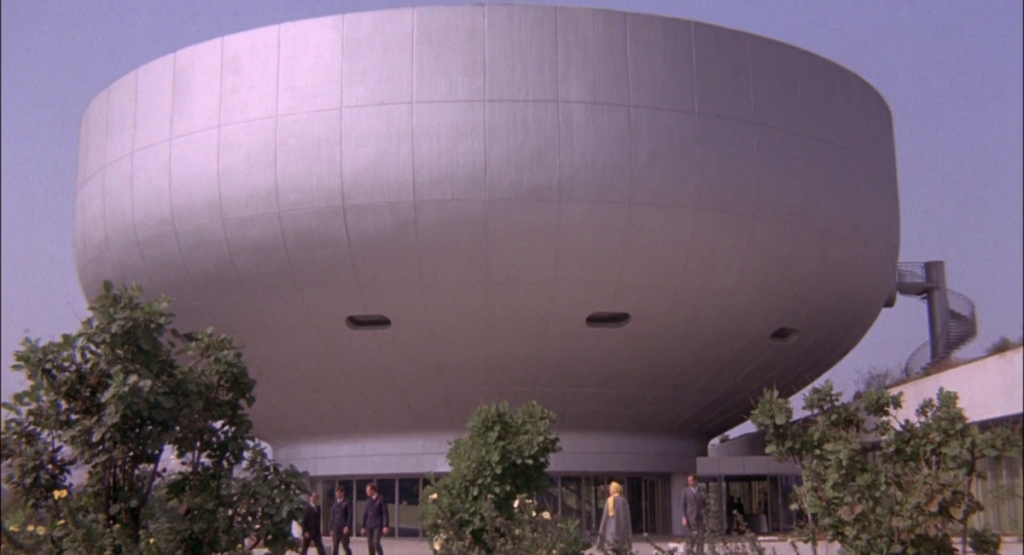I first watched Rollerball (Jewison, 1975) on VHS at a friend’s house in the early 1980s and naturally, at that age, was struck most by the spectacular gladiatorial game sequences. Although I have seen a few snippets here and there over the years, for various reasons I never managed to find an opportunity to sit down and watch the film again in its entirety. Last year would have been ideal, given that the film is set in 2018, but ideals are rarely realised and it was only a few weeks ago when I succeeded in returning to Rollerball, this time on the Blu-Ray released in 2014 by Twilight Time.
A quick summary of the plot may be in order for those unfamiliar with the film. The screenplay was written by William Harrison – adapted from his own short story, ‘Roller Ball Murder’, published in Esquire magazine in September 1973 – and a portrays a futuristic world in which nation-states have been replaced by six global corporations: Energy, Food, Transport, Communications, Housing and Luxury. The world has been transformed in the wake of what is referred to as ‘the corporate wars’, although no-one seems able to recall precise details. There are no more conflicts being fought in the world – except for Rollerball, a violent sport in which two teams on roller skates and motorbikes battle it out in vast circular arenas. The game is filmed and broadcast weekly, providing a distraction for the masses as well as a vicarious means by which social tensions, aggression and potential protests are safely channelled away from the corporations.

There are many echoes here – the cynical ‘bread-and-circuses’ of the Roman elite, the use of recreational drugs to control the populace in Brave New World, the anti-capitalist critiques of Marx and others, although the actual details of how this all came about, and how it functions, are (perhaps wisely) left vague and unclear.
Returning to the film after some thirty five years – a period in which my own world has been transformed considerably – it was only natural that this historic sense of world-building would draw my interest. Although the film’s reputation has been built upon the violent action of the game sections, these only comprise a small proportion of the film’s running time, and what really struck me on rewatching Rollerball is how much of it is subdued and restrained. Take the opening shots: instead of jumping headlong into the action, the film begins with scenes of preparation in the stadium as engineers and technicians prepare the stage. Then we see the bikes, but they are almost totally hidden in shadow as they run through the tunnel. A great deal of the film is dialogue, and in between the game sequences the pacing is slow – almost too slow at times, it must be said.

The narrative follows Jonathan (James Caan) the leading Rollerball player, whose skill in the game has made him a fan favourite, earning the disapproval of the head of the energy corporation, Mr Bartholomew (John Houseman). Pressure is put on Jonathan to retire, but his refusal leads to the Rollerball games becoming more dangerous as the rules are adjusted to make death or serious injury inevitable. Jonathan’s increasing unease with the situation leads to him carrying out his own investigations into the history of the ‘corporate wars’ as well as some of the circumstances surrounding the departure of his ex-wife.

Following his role as Sonny Corleone in The Godfather (1972) and The Godfather Part II (1974), Caan was a major star, but his break-out came playing Randall O’Connell in Lady in a Cage. According to Hedda Hopper in the Los Angeles Times (25 March 1963), Olivia de Havilland admired Caan’s performance and sought to get him the leading role in Youngblood Hawke after Warren Beatty dropped out – although it was in fact James Franciscus who got the part. Caan’s skill at playing volatile mavericks fitted well with the role of Jonathan in Rollerball, although the film’s air of restraint meant that the actor rarely found opportunity to show much in the way of real emotional depth or range in his character.
And perhaps it’s that aura of quietness and uneasy languor that made the most impression on me this time round. When I first watched Rollerball I was barely in my teens and, naturally, my attention was drawn chiefly to the exciting game sequences. While these attracted controversy at the time and produced the film’s most famous and abiding images, they comprise only a tiny proportion of its content: less than xx minutes out of a total running time of xx. As one grows older
My enjoyment of the film was much enhanced by reading Andrew Nette’s excellent study of Rollerball, written for the Constellation series. As well as providing an excellent guide to the film’s production, structure and narrative, the book places the story within the wider context of contemporary science fiction cinema and political anxieties, draws fascinating parallels with contemporary issues over ‘fake news’ and reality TV, and – especially welcome – includes an interview with Norman Jewison as well as many insights drawn from the William Harrison archive.
